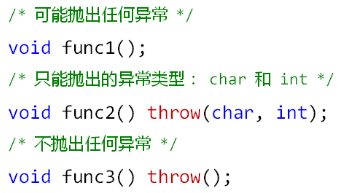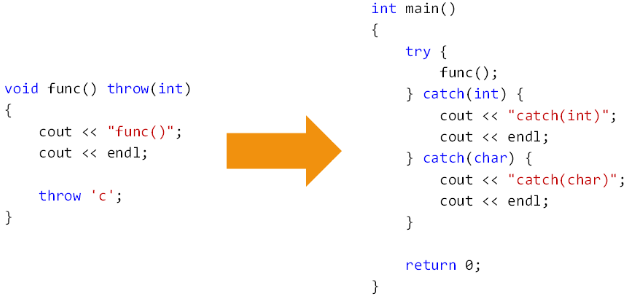C++解析-外传篇(2):函数的异常规格说明
2024-10-13 22:35:25
0.目录
1.异常规格说明
2.unexpected() 函数
3.小结
1.异常规格说明
问题:
如何判断一个函数是否会抛出异常,以及抛出哪些异常?
- C++提供语法用于声明函数所抛出的异常
- 异常声明作为函数声明的修饰符,写在参数列表后面

异常规格说明的意义:
- 提示函数调用者必须做好异常处理的准备
- 提示函数的维护者不要抛出其它异常
- 异常规格说明是函数接口的一部分
问题:
如果抛出的异常不在声明列表中,会发生什么?
下面的代码的输出什么?

示例——异常规格之外的异常:
#include <iostream>
using namespace std;
void func() throw(int)
{
cout << "func()";
cout << endl;
throw 'c';
}
int main()
{
try
{
func();
}
catch(int)
{
cout << "catch(int)";
cout << endl;
}
catch(char)
{
cout << "catch(char)";
cout << endl;
}
return 0;
}
运行结果为:
[root@bogon Desktop]# g++ test.cpp
[root@bogon Desktop]# ./a.out
func()
terminate called after throwing an instance of 'char'
Aborted (core dumped)
(不同编译器运行结果不一样。)
2.unexpected() 函数
- 函数抛出的异常不在规格说明中,全局 unexpected() 被调用
- 默认的 unexpected() 函数会调用全局的 terminate() 函数
- 可以自定义函数替换默认的 unexpected() 函数实现
- 注意:不是所有的C++编译器都支持这个标准行为
unexpected() 函数的替换:
- 自定义一个无返回值无参数的函数
- 能够再次抛出异常
- 当异常符合触发函数的异常规格说明时,恢复程序执行
- 否则,调用全局 terminate() 函数结束程序
- 能够再次抛出异常
- 调用 set_unexpected () 设置自定义的异常函数
- 参数类型为
void (*) () - 返回值为默认的 unexpected() 函数入口地址
- 参数类型为
示例1——自定义 unexpected() 函数:
#include <iostream>
#include <cstdlib>
#include <exception>
using namespace std;
void my_unexpected()
{
cout << "void my_unexpected()" << endl;
exit(1);
}
void func() throw(int)
{
cout << "func()";
cout << endl;
throw 'c';
}
int main()
{
set_unexpected(my_unexpected);
try
{
func();
}
catch(int)
{
cout << "catch(int)";
cout << endl;
}
catch(char)
{
cout << "catch(char)";
cout << endl;
}
return 0;
}
运行结果为:
[root@bogon Desktop]# g++ test.cpp
[root@bogon Desktop]# ./a.out
func()
void my_unexpected()
将exit();改为throw 1;后的运行结果:
示例2——自定义 unexpected() 函数:
void my_unexpected()
{
cout << "void my_unexpected()" << endl;
// exit(1);
throw 1;
}
运行结果为:
[root@bogon Desktop]# g++ test.cpp
[root@bogon Desktop]# ./a.out
func()
void my_unexpected()
catch(int)
(程序恢复执行了。)
(unexpected() 函数是正确处理异常的最后机会,如果没有抓住这次机会,全局的 terminate() 函数就会被调用,当前程序就只能以异常结束告终。)
3.小结
- C++中的函数可以声明异常规格说明
- 异常规格说明可以看作接口的一部分
- 函数抛出的异常不在规格说明中,unexpected() 被调用
- unexpected() 中能够再次抛出异常
- 异常能够匹配,恢复程序的执行
- 否则,调用 terminate() 结束程序
最新文章
- css3 linear-gradient实现页面加载进度条效果
- linux 之静默安装oracle
- Take advantage of “Integrated Calling” to know whom suspect talked to
- Yii2.0中文开发向导——Yii2中多表关联查询(join、joinwith)(转)
- Ubuntu14.04.1 阿里apt源
- 较多java书籍的网站 tools138.com
- iOS 关于使用xib创建cell的两种初始化方式
- 记录一些容易忘记的属性 -- UIImageView
- iOS数据持久化-SQLite数据库使用详解
- ANDROID_MARS学习笔记_S01原始版_016_Service
- 【随记】SQL Server连接字符串参数说明
- Centos 7 学习之静态IP设置
- shell脚本实现冒泡排序
- 18 常用模块 random shutil shevle logging sys.stdin/out/err
- Direct3D 11 Tutorial 5: 3D Transformation_Direct3D 11 教程5:3D转型
- Graphviz的安装 - windows环境下
- 面向对象【day07】:类的特性介绍(四)
- 【windows核心编程】远程线程DLL注入
- 页面中href链接的碰撞
- mybatis源码追踪1——Mapper方法用法解析